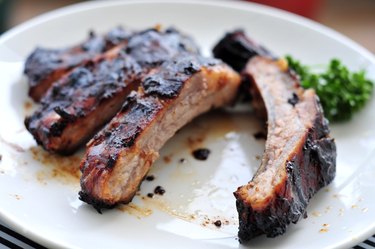Like shank and chuck, short ribs are a flavorful but forbiddingly tough cut of beef. Taming their leathery stubbornness usually requires long, slow cooking, which leaves the ribs lush and soft. This is a classic technique, and it makes a perfect cold-weather meal, but the finished short ribs lack the satisfyingly toothsome chewiness of a good steak or roast. You can pan-fry short ribs to achieve a similar result, but it does require a bit of preparation.

Video of the Day
Taming the Toughness
Short ribs come from the portion of a steer's ribs closest to the equally tough plate muscle, which is usually made into corned beef. Long, slow cooking breaks down the bonds between their muscle fibers and dissolves the tough connective tissues into lush, moist natural gelatin. Quick cooking doesn't do that, so you'll need to rely on other methods to tame the ribs' toughness. Marinades and commercial meat tenderizers help slightly, as will pounding the ribs with a meat mallet. The most crucial technique, though, is simply slicing the ribs thinly. This severs the long, tough muscle fibers, leaving them shorter and more chewable.
Video of the Day
Flanken the Opposition
Butchers call thin strips of short ribs "flanken-cut" ribs, and sell them in strips ranging from 1/2- to 1-inch thick. If you've already bought short ribs as a solid or English-cut slab, or individual bones, simply cut the meat from the bones -- save those for broth -- and then slice it thinly against the grain. It's easier to do this if you put the beef into your freezer for 15 to 20 minutes until it's slightly stiffened but not completely frozen. You can slice them up to 1/2-inch thick, though thinner is better.
The Stir-Fry Option
If you choose to slice the short ribs very thin, they'll work well in a stir-fry. Preheat your wok or skillet to medium-high and start with aromatic vegetables such as scallions, ginger and garlic to flavor the oil. Then add the beef in small quantities, whisking it through the hot oil until it's well browned. Finish them with your choice of sauce and serve them over stir-fried vegetables and rice or noodles. Although this technique is primarily used in Asian cookery, you can still give it a Western twist. You could just as easily finish the dish with Italian or Mexican flavors, for example.
Thicker Strips
Korean restaurants often marinate and grill strips of short ribs, to make a signature dish called kalbi. Ribs cooked at moderately high temperature in a heavy cast-iron skillet can achieve a similar result. Don't try to cook the ribs to rare or medium-rare as you would with a steak. They must be fully cooked for their connective tissues to melt and soften. Season the ribs with salt and pepper, a dry spice rub or a marinade -- kalbi marinade, if you're looking to replicate the Korean specialty -- before cooking. Blot any liquid from their surface; then lay them into the hot, lightly oiled skillet. Cook for 2 to 4 minutes per side, depending on their thickness, until they're well browned and cooked all the way through.
A Finishing Touch
At times, you might find yourself with a quantity of short ribs left over from a previous meal. These ribs, already slow-cooked in the traditional way, can be elevated notably by pan-frying. Simply wipe the ribs clean of any leftover sauce, and then sear them in a hot skillet until they're well browned on each side. The browning process -- a combination of caramelization and "Maillard reactions" -- creates rich, savory flavors in the beef. When the ribs are well browned, you can glaze them if you wish by adding a small quantity of sauce to the pan and shaking it until the ribs are well coated.